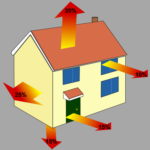 With winter approaching, The Green Cocoon has five easy ways for homeowners to increase energy efficiency and save money, besides using our fabulous spray foam insulation! As the weather gets cooler, your furnace will start to come on and that means you’ll be using more energy. Consequently, your heating bills will increase. Try these five easy DIY (do-it-yourself) projects to help cut down on energy loss and expenses.
With winter approaching, The Green Cocoon has five easy ways for homeowners to increase energy efficiency and save money, besides using our fabulous spray foam insulation! As the weather gets cooler, your furnace will start to come on and that means you’ll be using more energy. Consequently, your heating bills will increase. Try these five easy DIY (do-it-yourself) projects to help cut down on energy loss and expenses.
Replace worn weather stripping around doors and windows
Did you know that worn weather stripping can create drafts and let cold air in? This puts a high demand on your furnace and takes away your comfort. Replacing it takes little time and is a low-cost, high-impact solution.
Caulk around windows to increase energy efficiency
Cracks and crevices are a source of heat loss. They can also be an entryway for water/moisture, as well as for undesired insects. Preventative maintenance, such as caulking, can improve energy efficiency and prevent costly repairs.
Change your furnace filter
A dirty furnace filter means less efficiency and that costs money! Check your furnace filter monthly and if it’s dirty, change it or have it changed. Moreover, have a technician come in and inspect the entire furnace at least once per year.
Update light bulbs to LEDs to save money
LED is a highly energy-efficient lighting technology, and has the potential to fundamentally change the future of lighting in the United States. Residential LEDs—especially ENERGY STAR rated products—use at least 75 percent less energy, and last 25 times longer than incandescent lighting.1
An automatic thermostat increases energy efficiency and saves money
You can save money and increase energy efficiency on your heating and cooling bills by simply resetting your thermostat when you are asleep or away from home. You can do this automatically, without sacrificing comfort, by installing an automatic setback or programmable thermostat.
Contact us if you have questions on how you can save even more money on your heating bills.
__________________________________________
1 Department of Energy (2019). LED Lighting. Retrieved from energy.gov.






